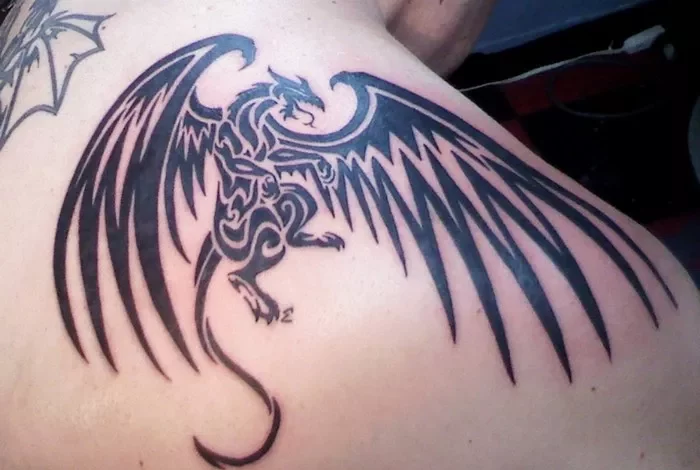Korean dragon tattoos are rich in symbolism and cultural heritage, drawing from centuries of mythology and tradition. In Korea, dragons are revered as powerful and benevolent creatures, unlike the more fearsome representations found in other cultures. This article delves into the meanings, history, and design elements of Korean dragon tattoos, helping you appreciate their significance.
Understanding the Korean Dragon
1. Characteristics of Korean Dragons
Korean dragons, known as “yong,” are distinct from Western dragons. They are typically depicted as:
Serpentine: Long and slender bodies resembling snakes, symbolizing grace and agility.
Three Clawed Feet: Unlike their Chinese counterparts with four claws, Korean dragons often have three, reflecting their unique status in East Asian mythology.
Horns and Whiskers: Prominent horns and long whiskers, adding to their majestic appearance.
2. Cultural Significance
In Korean culture, dragons are symbols of power, wisdom, and protection. They are often associated with water, particularly rainfall and rivers, playing a crucial role in agriculture and prosperity. Dragons are believed to control rain and wind, making them vital for a fertile land.
Symbolism of Korean Dragon Tattoos
1. Power and Authority
Korean dragons are emblematic of power and authority. They are often linked to the Korean monarchy, serving as symbols of the emperor’s strength and divine right to rule. A tattoo of a Korean dragon can represent personal empowerment and ambition.
2. Protection and Good Fortune
These tattoos are also seen as protective symbols. In folklore, dragons are guardians of treasures and knowledge. A Korean dragon tattoo is believed to bring good fortune and ward off negative energies, making it a popular choice for those seeking blessings in life.
3. Spiritual Awakening
Korean dragons are often associated with spiritual transformation and enlightenment. The journey of the dragon, often depicted ascending to the heavens, symbolizes personal growth and the pursuit of higher consciousness. Wearers may choose this tattoo to reflect their own spiritual journeys.
4. Harmony with Nature
Dragons are closely tied to natural elements, particularly water. They symbolize the balance between humans and nature, reminding wearers of the importance of harmony in their lives. This aspect resonates with those who value environmental consciousness and sustainability.
Designing a Korean Dragon Tattoo
1. Elements of Design
When considering a Korean dragon tattoo, the design elements are crucial in conveying its meaning. Key components include:
Body Position: The dragon can be depicted in various poses, such as coiling or flying, symbolizing different qualities like movement, freedom, or protection.
Facial Features: The expression of the dragon can convey emotions ranging from fierce determination to serene wisdom.
Surrounding Motifs: Common motifs include clouds, waves, and lotus flowers, which enhance the tattoo’s meaning and aesthetic appeal.
2. Placement of the Tattoo
The placement of a Korean dragon tattoo can influence its significance. Common areas include:
Back: Provides ample space for detailed designs and symbolizes strength and support.
Arms: Represents action and determination, ideal for those seeking to embody the dragon’s power.
Chest: Close to the heart, symbolizing personal protection and spiritual connection.
The Process of Getting a Korean Dragon Tattoo
1. Choosing a Tattoo Artist
Selecting an artist experienced in traditional Korean designs is essential. Look for someone who understands the cultural significance and can create a tattoo that resonates with your intentions. Research portfolios and read reviews to find the right fit.
2. Preparation
Before getting the tattoo, it’s essential to prepare both physically and mentally:
Health: Ensure you are in good health and avoid alcohol or blood thinners before your appointment.
Mindset: Approach the process with respect for the cultural significance of the tattoo.
3. Aftercare
Proper aftercare is vital for the healing process and longevity of the tattoo. Key practices include:
Keep it Clean: Gently wash the area with mild soap and water.
Moisturize: Use a fragrance-free lotion to keep the skin hydrated.
Avoid Sun Exposure: Protect the tattoo from the sun to prevent fading.
The Role of Korean Dragon Tattoos in Modern Culture
1. Popularity Among Different Cultures
Korean dragon tattoos have gained popularity beyond Korea, attracting individuals from diverse backgrounds. People are drawn to these tattoos not only for their aesthetic appeal but also for their profound meanings.
2. Fashion and Art
In contemporary fashion, Korean dragon tattoos often appear in clothing, accessories, and art. Designers incorporate these motifs, celebrating their beauty while educating others about their significance.
3. Spirituality and Mindfulness
Many modern wearers view their Korean dragon tattoos as a source of inspiration for spiritual growth and mindfulness. The tattoo serves as a reminder of their journey and commitment to personal development.
Common Misconceptions
1. Cultural Appropriation
One common concern is whether getting a Korean dragon tattoo constitutes cultural appropriation. It’s important to approach the tattoo with respect and understanding of its cultural significance. Engaging with the culture and its meanings can help alleviate this concern.
2. Misunderstanding of Symbolism
Some people may mistakenly interpret the Korean dragon tattoo purely as a decorative element. Understanding the rich symbolism behind the design adds depth to the tattoo and honors its origins.
Conclusion
Korean dragon tattoos embody powerful meanings that encompass strength, protection, spiritual awakening, and harmony with nature. As a blend of artistry and cultural heritage, they serve as significant symbols for those who wear them. Whether you are considering this tattoo for its beauty or its deep significance, understanding its cultural context enhances the experience and connection to the art. As you embark on your tattoo journey, remember to approach it with respect, ensuring that the story behind your Korean dragon tattoo is honored and celebrated.
Related topics:

